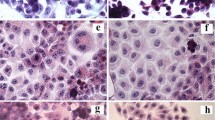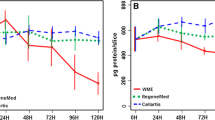Summary
The effects of four barbiturates with or without liver-tumor-promoting activity were examined on survival and deoxyribonucleic acid (DNA) synthesis of suckling and adult rat, hepatocytes in serum-free primary culture. Of the four barbiturates, two promoters, phenobarbital and barbital, enhanced DNA synthesis of suckling rat hepatocytes at low concentrations of 0.5–2 mM or 0.5 mM, but suppressed it at high concentrations of 3 mM or 1.5–4 mM. DNA synthesis of adult rat hepatocytes was, however, only suppressed by phenobarbital within the dose range tested of 1–3 mM. On the other hand, two remaining non-promoters, barbituric acid and amobarbital, did not increase but only suppressed DNA synthesis of suckling rat hepatocytes within the dose ranges of 0.5–4 mM and 0.05–0.5 mM respectively. Phenobarbital and amobarbital were effective for supporting survival and maintaining morphological features of suckling and adult rat hepatocytes at the relatively high concentrations of 3–4 mM and 0.5–0.75 mM respectively. However, barbital and barbituric acid were ineffective for maintenance of hepatocytes. The results show that the ability to support survival of primary cultured hepatocytes is not a common property of liver-tumor-promoter barbiturates but is a common property of some barbiturates with high lipophilicity and that the maintenance of hepatocytes by phenobarbital or amobarbital is not due to a counterbalance of stimulated proliferation and death of the cells.
Similar content being viewed by others
Abbreviations
- PBS:
-
Ca2+-and Mg2+-free phosphate-buffered saline
- EDTA:
-
ethylenediaminetetraacetic acid
- HEPES:
-
N-2-hydroxyethylpiperazine-N′-2-ethanesulfonic acid
- Cl3AcOH:
-
trichloroacetic acid
- DNA:
-
deoxyribonucleic acid
References
Diwan BA, Rice JM, Ohshima M, Ward JM, Dove LF (1985) Comparative tumor-promoting activities of phenobarbital, amobarbital, barbital sodium, and barbituric acid on livers and other organs of male F344/NCr rats following initiation withN-nitrosodiethylamine. J Natl Cancer Inst 74:509–516
Edwards AM, Lucas CM (1985) Phenobarbital and some other liver tumor promoters stimulate DNA synthesis in cultured rat hepatocytes. Biochem Biophys Res Commun 131:103–108
Handa Y, Miyazaki M, Sato J (1986a) Perfusion technique of suckling rat liver, and comparison of cytologic and biochemical properties between hepatocytes isolated from suckling and adult rats. Res Exp Med 186:121–131
Handa Y, Miyazaki M, Sat J (1986b) Comparative study of proliferation of suckling and adult rat hepatocytes in primary culture in response to grwoth-stimulating factors. Acta Med Okayama 40:321–326
Katsuta H, Takaoka T (1976) Improved synthetic media suitable for tissue culture of various mammalian cells. Methods Cell Biol 14:145–158
Kaufmann WK, Ririe DG, Kaufmann DG (1988) Phenobarbitaldependent proliferation of putative initiated rat hepatocytes. Carcinogenesis 9:779–782
Kitagawa T, Watanabe R, Kayano T, Sugano H (1980) In vitro carcinogenesis of hepatocytes obtained from acetylaminofluorenetreated rat liver and promotion of their growth by phenobarbital. Gann 71:747–754.
Kunz HW, Tennekes HA, Port RE, Schwartz M, Lorke D, Schaude G (1983) Quantitative aspects of chemical carcinogenesis and tumor promotion in liver. Environ Health Perspect 50:113–122
Lowry OH, Rosebrough NJ, Farr AL, Randall RJ (1951) Protein measurement with Folin phenol reagent. J Biol Chem 193:265–275
Miyazaki M, Tsunashima M, Wahid S, Miyano K, Sato J (1984) Comparison of cytologic and biochemical properties between liver cells isolated from adult rats, by trypsin perfusion and those isolated by collagenase perfusion. Res Exp Med 184:191–204
Miyazaki M, Handa Y, Oda M, Yabe T, Miyano K, Sato J (1985a) Long-term survival of functional hepatocytes from adult rat in the presence of phenobarbital in primary, culture. Exp Cell Res 159:176–190
Miyazaki M, Handa Y, Sato J (1985b) Effect of phenobarbital on adult rat liver cells treated with 3′-methyl-4-dimethylaminoazobenzene in primary culture. J Cancer Res Clin Oncol 110:191–195
Miyazaki M, Handa Y, Suzuki Y, Sato J (1986) Promotion of 3′-methyl-4-dimethyl-aminoazobenzene-initiated adult rat liver cells to malignant state by phenobarbital in culture. Int J Cancer 37:769–773
Miyazaki M, Handa Y, Suzuki Y, Sato J (1987) Effect, of various barbituric acid derivatives on survival of functional hepatocytes from adult rats in primary culture. Res Exp Med 187:105–117
Miyazaki M, Suzuki Y, Sato J (1988) A method for rapid preparation of single-cell suspensions from rat hepatocyte primary cultures on collagen substratum and the mechanism of cell dissociation. Acta Med Okayama 42:351–354
Miyazaki M, Suzuki Y, Oda M, Kawai A, Bai L, Sato J (1989) Improved maintenance of adult rat hepatocytes in a new serum-free medium in the presence or absence of barbiturates. In Vitro Cell Dev Biol 25:839–848
Miyazaki M, Bai L, Sato J (1990a) Influence of liver tumor promoters and structurally related chemicals on survival of nomral adult rat hepatocytes in primary culture. J Cancer Res Clin Oncol 116:259–263
Miyazaki M, Bai L, Tsuboi S, Ohmori S, Ogata K, Sato J, Namba M (1990b) Enhancing effect ofS-(1,2-dicarboxyethyl)glutathione on epidermal growth factor-stimulated DNA synthesis in primary cultures of adult rat hepatocytes. Res Exp Med 190:381–387
Moore MA, Hacker HJ, Kunz HW, Bannasch P (1983) Enhancement of NMN-induced carcinogenesis in the rat liver by phenobarbital: a combined morphological and enzyme histochemical approach. Carcinogenesis 4:473–479
Nakamura T, Tomita Y, Ichihara A (1983) Density-dependent growth control of adult rat hepatocytes in primary culture. J Biochem (Tokyo) 94:1029–1035
Nakamura T, Fujii T, Ichihara A (1988) Autocrine mechanism of growth of neonatal rat hepatocytes in primary culture. J Biochem (Tokyo) 103:700–706
Nakanishi K, Fukushima S, Hagiwara A, Tamano S, Ito N (1982) Organ-specific promoting effects of phenobarbital sodium and sodium saccharin in the induction of liver and urinary bladder tumors in male F344 rats. J Natl Cancer Inst 68:497–500
Peraino C, Fry RJM, Staffeldt E, Christopher JP (1975) Comparative enhancing effects of phenobarbital, amobarbital diphenylhydantoin, and dichlorodiphenyltrichloroethane on 2-acetyl-aminofluorene-induced hepatic tumorigenesis in the rat. Cancer Res 35:2884–2890
Rotstein J, Sarma DSR, Farber E (1986) Sequential alterations in growth control and cell dynamics of rat hepatocytes in early precancerous steps in hepatocarcinogenesis. Cancer Res 46:2377–2385
Sawada N, Staecker JL, Pitot HC (1987) Effects of tumor-promoting agents 12-O-tetradecanolphorbol-13-acetate and phenobarbital on DNA synthesis of rat hepatocytes in primary culture. Cancer Res 47:5665–5671
Schulte-Hermann R (1985) Tumor promotion in the liver. Arch Toxicol 57:147–158
Yusof YAM, Edwards AM (1990) Stimulation of DNA synthesis in primary rat hepatocyte cultures, by liver tumor promoters: interactions with other growth factors. Carcinogenesis 11:761–770
Author information
Authors and Affiliations
Rights and permissions
About this article
Cite this article
Miyazaki, M., Bai, L., Tsuboi, S. et al. Effects of barbiturates with or without liver-tumor-promoting activity on survival and DNA synthesis of suckling and adult rat hepatocytes in serum-free primary culture. J Cancer Res Clin Oncol 118, 435–440 (1992). https://doi.org/10.1007/BF01629426
Received:
Revised:
Issue Date:
DOI: https://doi.org/10.1007/BF01629426




